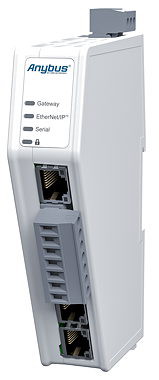- Home » News » Product News
20 years on, gateways reach their second generation

HMS Networks has announced a second generation of its Anybus Communicator gateway family for connecting devices and machines to industrial networks, almost 20 years after the first generation was released. Millions of devices and machines now rely on Communicators for network connections in a wide range of industrial applications. The two generations will co-exist with separate lifecycle plans.
Depending on the application, data cycle times for the new Communicators can be up to 10 times faster than for the first generation, thanks to new hardware and software. Data exchange has been boosted significantly, with up to 1,448 bytes being transferred from a PLC to the gateway, and from the gateway to the PLC.
The new Communicators are powered by HMS’ Anybus NP40 industrial network processor, and are packaged in slim DIN-rail mounting housings. To meet current and future security challenges, the gateways are equipped with security chips. A secure boot ensures that the firmware cannot been tampered with.
Initially, an EtherNet/IP version has been released that supports DLR (device level ring) with Beacon Mode for media redundancy, network fault detection, and network fault resolution. Communications can continue even if a cable breaks.
Versions for Modbus TCP, Profinet and Profibus will follow this year and next.

Initially, the second-generation Communicators are focusing mainly on Modbus RTU communications. They support up to 150 Modbus commands, for complex configurations with multiple nodes. The configurations can be stored and managed securely for future use. The gateways can be included as nodes in PLC systems on the other side of the gateway.
A configuration port and Web interface allow users to monitor and diagnose network traffic. They can see, immediately, the status of network connections, serial connections, and individual serial nodes. Communication logs are provided for further analysis.
Before connecting a gateway to an uplink PLC, the user configures it to communicate with a subnet of one or more devices/machines. This is done by connecting to the Ethernet configuration port from a PC, after which the user can open a browser to access a graphical, Web-based interface. Configurations are achieved using drag-and-drop functions, with no additional software being needed.





